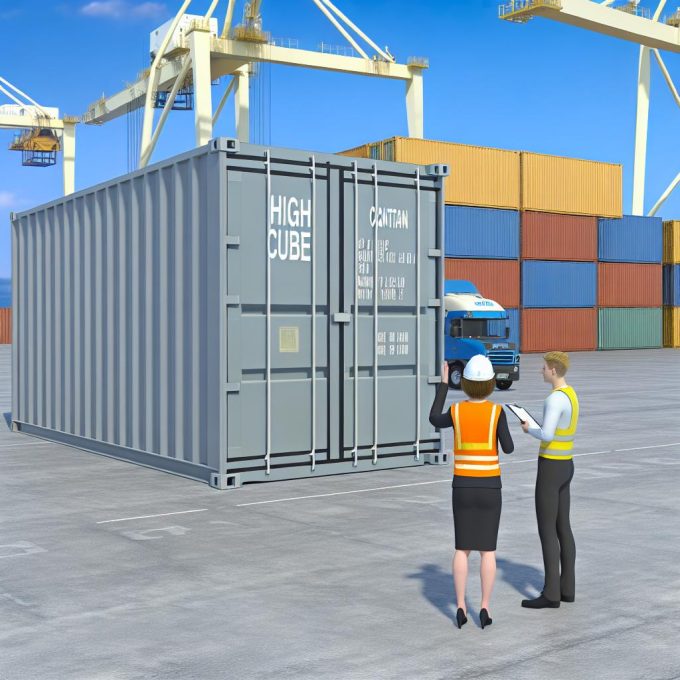Understanding High Cube Containers
High cube containers are a specialized type of shipping container that provides additional vertical space compared to standard containers. They have been increasingly used in international shipping due to their ability to hold more cargo without requiring a larger base. Typically, a high cube container is 9.5 feet tall, which is one foot taller than the standard 8.5-foot containers. This additional height offers logistical advantages, especially for transporting bulky or voluminous goods.
Dimensions and Specifications
The most common size for a high cube container is the forty-foot version, known as a 40-foot high cube container. These containers have the same length and width as standard containers, but they offer an internal height of approximately 2.70 meters. The increased height allows businesses to maximize vertical stacking, thus optimizing space usage and potentially reducing the number of trips required to transport the same volume of goods.
Capacity and Usage
High cube containers have a slightly larger capacity compared to standard containers. For instance, the typical internal capacity of a 40-foot high cube container is around 76 cubic meters, which is significantly more than the 67 cubic meters that a standard 40-foot container can hold. This makes high cube containers highly desirable for transporting lightweight, bulky goods, where maximizing volume is more crucial than weight limits. Additionally, they are often used for shipping items that require a little extra vertical space, such as machineries or large furniture.
Advantages in Logistics
Using high cube containers can offer several advantages in logistics and shipping operations. The increased volume capacity is a notable benefit, as the extra height provides more room to load goods, which can be an efficient way to transport more products on one trip. Flexibility is another advantage; high cube containers are ideal for companies dealing with irregularly sized goods or materials that do not fit perfectly into standard containers. Moreover, by maximizing the volume within a single container, companies can potentially cut down on shipping costs per unit. This cost-efficiency becomes particularly valuable in a competitive marketplace where transportation costs can significantly impact profit margins.
The Impact on Supply Chains
Incorporating high cube containers into supply chains can have a profound effect on logistics management. The ability to transport more goods in fewer trips can streamline operations, reduce transit times, and result in fewer emissions due to reduced fuel consumption, thereby enhancing sustainability efforts. Additionally, for businesses that rely on just-in-time delivery models, having the flexibility to adjust shipment volumes more easily with high cube containers can lead to improved inventory management and reduced stockouts. The capacity to better accommodate fluctuating demand without compromising on logistical efficiency is a compelling advantage in today’s dynamic markets.
Considerations and Limitations
While high cube containers offer many benefits, shippers must consider certain limitations. Not all port facilities and transport methods are designed to accommodate the extra height, which could impose restrictions on usage. Additionally, high cube containers may require special handling equipment for stacking and transportation. It is essential to evaluate infrastructure capabilities at both the origin and destination points to ensure seamless integration into logistics processes.
Regulatory and Technical Challenges
There are also regulatory and technical challenges associated with high cube containers. Some regions may have height restrictions or specific regulations regarding the transportation of oversized loads. Additionally, high cube containers may require different securing mechanisms during transit to prevent shifting or damage. Businesses need to factor these elements into their logistics planning to avoid unexpected delays or compliance issues. Engaging with experts in container logistics can provide valuable insights and help mitigate potential risks associated with using high cube containers.
Choosing the Right Container for Business Needs
Prior to selecting high cube containers for shipping needs, businesses should evaluate their specific requirements, considering both the benefits of additional capacity and any potential logistical challenges. It is crucial to conduct a thorough cost-benefit analysis, taking into account factors such as the nature of the goods being transported, frequency of shipments, and destination specifics. Consulting with specialized container suppliers or logistics service providers can access more detailed specifications and purchasing options and better inform decision-making processes.
Moreover, forward-thinking businesses might explore leasing options as an alternative to purchasing high cube containers outright. Leasing may provide flexibility and cost savings, especially if the need for high cube containers is temporary or subject to change based on market conditions. Some suppliers offer customizable leasing terms that allow companies to scale container usage in alignment with their logistical requirements, thereby optimizing operational efficiency without significant upfront capital expenditure.
For more information on shipping containers, consider visiting industry websites such as the Container Home Plans or professional shipping and logistics service providers. These resources can offer valuable insights and guidance tailored to specific industry needs.

